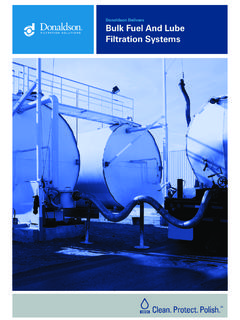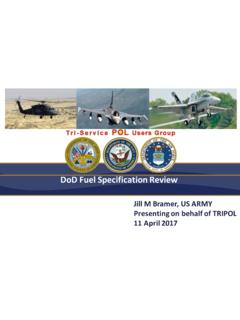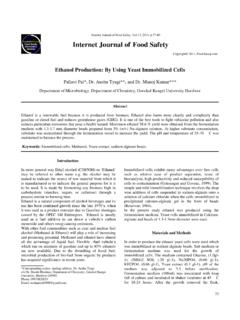Transcription of TEST CASE - Drew Marine
1 TEST CASEFUEL QUALITY UNDER SCRUTINYINSIDE:TRAINING & EDUCATIONREGULATIONSREGIONAL SPOTLIGHTFINANCIAL Volume 11 Number 3 June/July 2014 In the coming months, ship operators who operate entirely or who traverse partly within an emission control area (ECA) must make final decisions over whether to use fuel oil with a maximum of sulphur content or to utilise an equivalent arrangement at least as effective in terms of emissions reductions ( , exhaust gas cleaning system, alternative fuel , etc.) for compliance. On 1 January, 2015, the International Maritime Organization (IMO) Resolution (58), commonly referred to as the revised MARPOL Annex VI, is expected to impact a major percentage of vessels, since most vessel voyages call on major trading ports in the pre-existing ECAs, namely the North Sea, Baltic Sea, United States and Canada, and the US Caribbean.
2 While it is expected that those operators who spend only a portion of their voyages inside an ECA will simply switch over to premium low sulphur distillate fuel oil whilst in the ECA, those operators who spend the majority of their time in an ECA would by now have already evaluated scrubbers and liquefied natural gas (LNG) as prominent alternatives. Prior to entering or exiting an ECA, the former operators are required to properly document how the fuel oil change-over was executed and to document the amount of low sulphur fuel volume, vessel position, date, and time. The latter must record the performance of their exhaust gas cleaning system or fuel switchover execution for switching from residual to distillate fuel oil sounds straightforward enough, although most Marine engineers would find the required cleaning process somewhat challenging, unless they have had prior exposure to tank cleaning procedures onboard tankers, specifically chemical parcel/product tankers.
3 In order to properly switch from one cargo to another cargo and avoid product contamination, chemical parcel/product tankers must follow recommended tank cleaning procedures. This is especially true when it comes to residual fuel oil, which is considered to be a dirty petroleum product (DPP). Even though Marine engineers are familiar with the fuel switchover process required for meeting the existing fuel sulphur content in an ECA, preparing the bunker tanks for permanently loading distillate fuel oil will involve additional to the increased number of customer inquiries on how to prepare their ships bunker tanks from carrying residual fuel oil or low sulphur residual fuel oil to distillate fuel oil, the following recommendation will ensure a smooth and permanent switchover.
4 Based on proper tank cleaning guidelines, these instructions are intended for operators that have followed routine bunker tank cleaning and inspection as per international, as well as any local, regulatory requirements. Ideally, full access to the nominated bunker tanks would be necessary, meaning the cleaning process should be done while the vessel is in dry dock. Residual fuel oil is considered to be a very difficult product to clean away as it includes not only the bunker tanks, but the pumps, pipelines, and crossover lines. The residual fuel oil is to be stripped and drained well from the bunker tanks. While hot sea water would work, it is recommended that a cleaning chemical be used since residual fuel oil is not water soluble. The types of cleaning chemicals that will work include degreasers, detergents, and/or multi-purpose cleaners.
5 Solvents, solvent cleaner, and/or hydrocarbon removers may also be necessary on stubborn or hard to reach residues and surfaces. Drew Marine recommends using TC#4 tank cleaner, which is a superior hydrophilic, solvent emulsifying detergent with a flash point greater than 60 C for cleaning petroleum residues. TC#4 tank cleaner can be applied via standard tank cleaning methods including machine cleaning or hand-spraying. TC#4 tank cleaner can also be applied to empty bunker tanks via sounding tubes, prior to dry dock using a two-step rock-and-roll procedure. For typical bunker tank conditions where sludge accumulation is normal and heating coils are capable of heating the tank to 38 C, 190 litres of TC#4 total per 100 tons tank capacity would be required. In order to handle excessive sludge and inadequate heating facilities, whereby 38 C is unachievable, 300 litres of TC#4 total per 100 tons tank capacity would be required.
6 Once in dry dock, the tank should be machine washed with heated sea water followed by a fresh water rinse, ensuring that all tank surfaces are completely rinsed. Ensuring that the bunker tank is isolated from other Switching over from residual to distillate fuel oil requires careful preparation of a vessel s tanks, as Albert Leyson of Drew Marine explainsGood housekeeping With increased market demand for distillate fuel oil, unscrupulous suppliers may include naturally low sulphur blend components (used lube oil, biofuel, chemical waste, etc.) into the Marine supply fuel June/July 2014tanks and that the oxygen level is less than 8% v/v and the hydrocarbon vapour content is less than 2% v/v, perform the gas-freeing operation. Continue with forced air ventilation until tests with an oxygen analyser show a steady oxygen reading of 21% v/v and tests up the cleaning process with ejection and then mop dry.
7 Inspect and check wallwash results to determine if further cleaning is operators that wish to do a majority of the cleaning in-situ, Drew Marine recommends applying a series of fuel additive treatments to at least four bunkerings before attaining compliance. Assuming that no type of fuel oil conditioner has ever been used before, prior to the next immediate bunkering dose all residual fuel oil tanks, including settling and service tanks, with AMERGY 222 conditioner at the lowest dosage rate of 1 litre to 15 cubic metres (m3). Before the subsequent bunkering, increase the dosage rate to all nominated bunker tanks to 1 litre to 10 m3. Prior to the last residual fuel oil bunkering, increase the dosage rate to all previously treated bunker tanks to 1 litre to 6 m3.
8 This will slowly clean the tanks of any accumulated sludge without overloading Before loading distillate fuel oil, dose AMERGY XLS low sulphur conditioner at 1 litre to 3 m3 to ensure compatibility with the assumed max 10% v/v ROB of residual fuel oil in each bunker tank. Remember that if a clear and bright ISO 8217:2012 DMA grade is loaded on top of residual fuel result will not meet the required sulphur content, appearance, and, quite possibly, the calculated cetane index (CCI) speci -cations. However, the remaining parameters have been calculated to meet the least stringent DMB distillate fuel oil order to meet the maximum fuel sulphur content, a second dilution of the resultant blend is required. (Refer to the table above.)As distillate fuel oils are more likely to be incompatible with other distillate fuel oils, Drew Marine recommends o ngoing tre atm e nt with AMERGY XLS at 1 litre to 5 m3 with each bunkering.
9 Treating with AMERGY XLS also prepares the fuel for extended fuel storage stability, improves fuel lubricity, and minimises .spit rotcejni no stisoped nobracWith the price of distillate fuel oil expected to steadily increase into 2015 due to increased market demand, protecting th i s ex p e n s i ve e n e rg y inve s tm e nt, as well as its loss through microbio -logical growth, will become paramount. The combination of the humid Marine environment and prolonged fuel storage can lead to increased fuel sludge. As a precaution, all distillate fuel oil bunkers should be treated with AMERSTAT 25 at 1 litre to 25 m3 to prevent microbial growth, microbially induced corrosion (MIC), and hydrogen sulphide (H2.)
10 Noitamrof )SWith increased market demand for distillate fuel oil, unscrupulous suppliers may include naturally low sulphur blend components ( , used lube oil, biofuel, .ylppus eniram eht otni ).cte ,etsaw lacimehcEven though the latest ISO 8217:2012 Marine de minimis li mit, even 1 mg/kg (ppm) of allowable contaminant over time can cause serious fuel injection related problems, especially with newer nitrogen oxide (NOx) Tier II+ diesel engines. To combat fuel injection-related issues as they occur due to contaminated distillate fuel oil, it is essential to have AMERGY ULS-D at the ready. Treating the distillate fuel oil service tank with AMERGY ULS-D at 1 litre to 5 m3 will clean injectors from lacquering, varnish, or any other foulant to restore proper.









